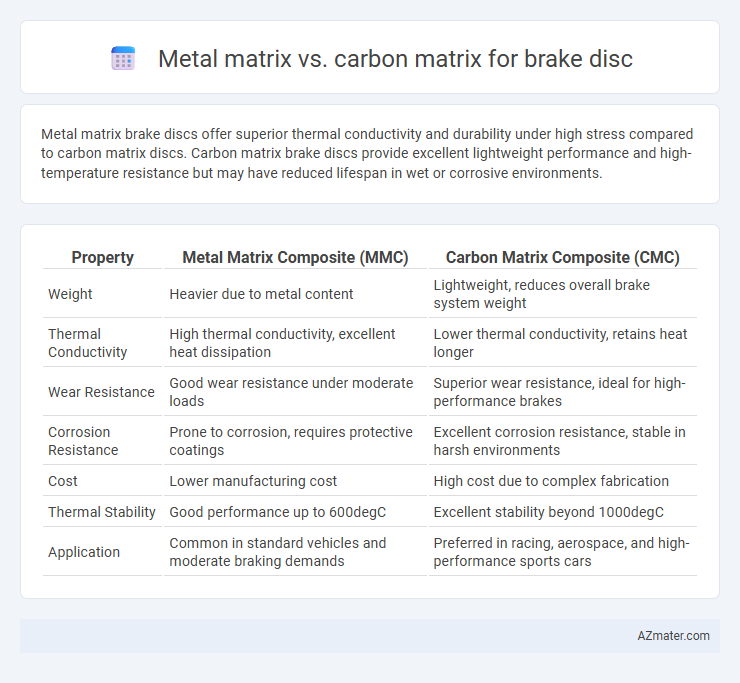Metal matrix brake discs offer superior thermal conductivity and durability under high stress compared to carbon matrix discs. Carbon matrix brake discs provide excellent lightweight performance and high-temperature resistance but may have reduced lifespan in wet or corrosive environments.
Table of Comparison
| Property | Metal Matrix Composite (MMC) | Carbon Matrix Composite (CMC) |
|---|---|---|
| Weight | Heavier due to metal content | Lightweight, reduces overall brake system weight |
| Thermal Conductivity | High thermal conductivity, excellent heat dissipation | Lower thermal conductivity, retains heat longer |
| Wear Resistance | Good wear resistance under moderate loads | Superior wear resistance, ideal for high-performance brakes |
| Corrosion Resistance | Prone to corrosion, requires protective coatings | Excellent corrosion resistance, stable in harsh environments |
| Cost | Lower manufacturing cost | High cost due to complex fabrication |
| Thermal Stability | Good performance up to 600degC | Excellent stability beyond 1000degC |
| Application | Common in standard vehicles and moderate braking demands | Preferred in racing, aerospace, and high-performance sports cars |
Introduction to Brake Disc Materials
Brake discs predominantly use metal matrix composites or carbon matrix materials, each offering distinct performance benefits. Metal matrix brake discs, often composed of aluminum reinforced with ceramic particles, provide excellent thermal conductivity and mechanical strength for conventional vehicles. Carbon matrix brake discs, commonly made from carbon-carbon composites, excel in high-temperature resistance and lightweight properties, making them ideal for high-performance and racing applications.
Overview of Metal Matrix Composites
Metal matrix composites (MMCs) for brake discs combine metals like aluminum or titanium with reinforcements such as silicon carbide or alumina to enhance thermal conductivity, wear resistance, and mechanical strength. These composites offer superior heat dissipation and reduced weight compared to traditional carbon matrix materials, improving braking performance and durability under extreme conditions. The integration of ceramic particulates within the metal matrix significantly boosts fracture toughness and thermal stability, making MMC brake discs ideal for high-performance automotive and aerospace applications.
Overview of Carbon Matrix Composites
Carbon matrix composites for brake discs offer superior heat resistance and reduced weight compared to traditional metal matrix composites, delivering enhanced thermal stability at extreme temperatures up to 1,200degC. These composites exhibit exceptional wear resistance and lower thermal expansion, resulting in improved braking performance and longevity in high-performance automotive and aerospace applications. The inherent high strength-to-weight ratio of carbon matrix composites contributes to reduced unsprung mass and increased fuel efficiency without compromising safety or durability.
Key Material Properties Comparison
Metal matrix brake discs exhibit superior thermal conductivity and higher fatigue resistance compared to carbon matrix counterparts, enabling efficient heat dissipation under extreme braking conditions. Carbon matrix brake discs offer exceptional lightweight properties and excellent wear resistance, which enhance vehicle performance and longevity in high-performance applications. Both matrices differ significantly in density, thermal expansion coefficients, and mechanical strength, influencing their suitability for specific automotive or aerospace braking systems.
Thermal Performance and Heat Dissipation
Metal matrix brake discs offer superior thermal performance due to their high thermal conductivity, allowing faster heat dissipation during braking. Carbon matrix discs provide excellent heat resistance and maintain structural integrity at extreme temperatures, reducing brake fade in high-performance applications. Metal matrices excel in rapid cooling cycles, while carbon matrices sustain consistent performance under prolonged thermal stress.
Durability and Wear Resistance
Metal matrix brake discs exhibit superior durability due to enhanced thermal conductivity and mechanical strength, which effectively dissipates heat and resists deformation under high-stress conditions. In contrast, carbon matrix brake discs offer exceptional wear resistance and lightweight properties, maintaining performance even at extreme temperatures without significant material degradation. The metal matrix is preferred for heavy-duty applications requiring long lifespan and consistent reliability, while carbon matrix is favored in high-performance scenarios demanding minimal weight and excellent endurance.
Weight and Efficiency Considerations
Metal matrix brake discs typically offer higher thermal conductivity and superior wear resistance, which enhances braking efficiency under high-stress conditions. Carbon matrix brake discs, being significantly lighter, reduce unsprung mass and improve vehicle handling, contributing to overall performance efficiency. The choice between metal and carbon matrices hinges on balancing weight reduction benefits against thermal performance requirements in braking systems.
Manufacturing Processes and Costs
Metal matrix brake discs typically utilize processes such as casting, powder metallurgy, and forging, which enable high thermal conductivity and durability but involve higher raw material and machining costs. Carbon matrix brake discs leverage chemical vapor infiltration and resin impregnation techniques, offering lightweight properties and excellent heat resistance but require complex production steps that increase manufacturing time and expenses. The cost-effectiveness of metal matrix discs arises from more established large-scale production methods, whereas carbon matrix discs demand specialized facilities and higher labor intensity, driving up overall costs.
Applications in Automotive and Aerospace
Metal matrix composites (MMCs) for brake discs outperform carbon matrix composites in high-load automotive applications due to superior thermal conductivity and wear resistance, ensuring enhanced durability under extreme temperatures. Carbon matrix composites excel in aerospace braking systems by offering significantly lower weight and exceptional heat dissipation, critical for aircraft landing gear performance and fuel efficiency. Automotive manufacturers favor metal matrix brake discs for heavy-duty vehicles, while aerospace industries prioritize carbon matrix composites for lightweight, high-performance braking solutions.
Future Trends in Brake Disc Technology
Metal matrix composites (MMCs) for brake discs offer superior thermal conductivity and wear resistance compared to carbon matrix materials, driving their adoption in high-performance and electric vehicles. Future trends emphasize hybrid composites combining metal and carbon matrices to optimize weight reduction while enhancing heat dissipation and structural integrity. Advanced manufacturing techniques like additive manufacturing and nano-reinforcements are poised to revolutionize brake disc performance, enabling tailored properties for next-generation braking systems.

Infographic: Metal matrix vs Carbon matrix for Brake disc
 azmater.com
azmater.com